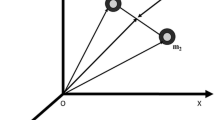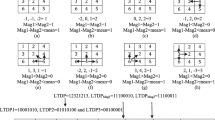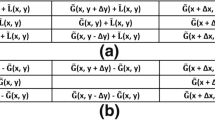Abstract
A face enhancement has the potential to play an important part in providing satisfactory and vast information to the face recognition performance. Therefore, a new approach for nonuniform illumination face enhancements (NIFE) was proposed by designing an adaptive contrast-stretching (ACS) filter. In a more objective manner of achieving this, an investigation usage of CS function with adjustable factors value to summarise its influence on the NIFE is examined firstly. Secondly, describe a new strategy to cater for CS adaptive factors prediction using training and testing phases. A dispersion versus location (DL) descriptor was examined in the training phase to generate the faces feature vectors. Subsequently, a frame differencing module (FDM) was developed for faces label generations. In the testing phase, the approach was examined to recognise the DL descriptor and predict face label based vocabulary tree model (VTM). Thirdly, the VTM performance was examined by referring to the area under curve (AUC) score from the receiver operating characteristic (ROC). The face quality measurement was evaluated via blind reference based statistical measures (BR-SM), blind reference based DL-descriptors (BR-DL) and visual interpretation of the resulting images. The BR-SM performed through calculating the EME (Measure of Enhancement), EEME (Measure of Enhancement by Entropy), SDME (Second Derivative like Measure of Enhancement), SHP (Coefficient of Sharpness) and CPP (Contrast per Pixel). In addition, by using DL scatter, the BR-DL handles the specific relationship with regards to the local contrast to local brightness within the resulting face images. Four face image databases, namely Extended Yale B, Mobio, Feret and CMU-PIE were used. The final results attained prove that compared to the state-of-the-art methods, the proposed ACS filter implementation is the most excellent choice in terms of contrast and nonuniform illumination adjustment as well as providing images of satisfactory quality. In short, the benefits attained proves that ACS is driven with a profitable enhancement rate in providing tremendous detail concerning face recognition systems.



























Similar content being viewed by others
References
Agaian S, Roopaei M, Akopian D (2014) Thermal-image quality measurements 2014 IEEE international conference on acoustics, speech and signal processing (ICASSP), pp 2779–2783. doi:10.1109/ICASSP.2014.6854106
Agaian S, Roopaei M, Shadaram M, Bagalkot SS (2014) Bright and dark distance-based image decomposition and enhancement 2014 IEEE international conference on imaging systems and techniques (IST) proceedings, pp 73–78. doi:10.1109/IST.2014.6958449
Agaian SS, Panetta K, Grigoryan AM (2000) A new measure of image enhancement IASTED international conference on signal processing & communication, Citeseer, pp 19–22
Agaian SS, Panetta K, Grigoryan AM (2001) Transform-based image enhancement algorithms with performance measure. IEEE Trans Image Process 10 (3):367–382
Arriaga-Garcia EF, Sanchez-Yanez RE, Garcia-Hernandez M (2014) Image enhancement using bi-histogram equalization with adaptive sigmoid functions International conference on electronics, communications and computers (CONIELECOMP), 2014. IEEE, pp 28–34
Brown CD, Davis HT (2006) Receiver operating characteristics curves and related decision measures: a tutorial. Chemom Intell Lab Syst 80(1):24–38
Chang S-J, Li S, Andreasen A, Sha X-Z, Zhai X-Y (2015) A reference-free method for brightness compensation and contrast enhancement of micrographs of serial sections. PloS one 10(5):e0127855
Chen W, Er MJ, Wu S (2006) Illumination compensation and normalization for robust face recognition using discrete cosine transform in logarithm domain. IEEE Trans Syst Man Cybern B Cybern 36(2):458–466
Choi Y, Kim H-I, Ro YM (2016) Two-step learning of deep convolutional neural network for discriminative face recognition under varying illumination. Electronic Imaging 2016(11):1–5
Eramian M, Mould D (2005) Histogram equalization using neighborhood metrics The 2nd Canadian conference on computer and robot vision (CRV’05). IEEE, pp 397–404
Faraji MR, Qi X (2014) Face recognition under varying illumination based on adaptive homomorphic eight local directional patterns. IET Comput Vis 9(3):390–399
Georghiades A, Belhumeur P, Kriegman D (2001) From few to many: illumination cone models for face recognition under variable lighting and pose. IEEE Trans Pattern Anal Mach Intell 23(6):643–660
Gross R, Brajovic V (2003) An image preprocessing algorithm for illumination invariant face recognition International conference on audio-and video-based biometric person authentication, Springer, pp 10–18
Hasikin K, Isa NAM (2012) Enhancement of the low contrast image using fuzzy set theory UKSIm 14th international conference on computer modelling and simulation (UKSim), 2012, IEEE, pp 371–376
Heusch G, Cardinaux F, Marcel S (2005) Lighting normalization algorithms for face verification. Tech rep, IDIAP
Hu H (2015) Illumination invariant face recognition based on dual-tree complex wavelet transform. IET Comput Vis 9(2):163–173
Jobson DJ, Rahman Z-u, Woodell GA (1997) A multiscale retinex for bridging the gap between color images and the human observation of scenes. IEEE Trans Image Process 6(7):965–976
Kryszczuk K, Drygajlo A (2006) On combining evidence for reliability estimation in face verification Signal processing conference, 2006 14th European. IEEE, pp 1–5
La Cascia M, Sclaroff S, Athitsos V (2000) Fast, reliable head tracking under varying illumination: an approach based on registration of texture-mapped 3d models. IEEE Trans Pattern Anal Mach Intell 22(4):322–336
Lai Z-R, Dai D-Q, Ren C-X, Huang K-K (2015) Multiscale logarithm difference edgemaps for face recognition against varying lighting conditions. IEEE Trans Image Process 24(6):1735–1747
Lee K-C, Ho J, Kriegman DJ (2005) Acquiring linear subspaces for face recognition under variable lighting. IEEE Trans Pattern Anal Mach Intell 27(5):684–698
Liang H, Weller DS (2016) Comparison-based image quality assessment for selecting image restoration parameters. IEEE Trans Image Process 25(11):5118–5130
McCool C, Marcel S, Hadid A, Pietikainen M, Matejka P, Cernocky J, Poh N, Kittler J, Larcher A, Levy C, Matrouf D, Bonastre J-F, Tresadern P, Cootes T (2012) Bi-modal person recognition on a mobile phone: using mobile phone data IEEE ICME workshop on hot topics in mobile multimedia
Mustapha A, Hussain A, Samad SA, Zulkifley MA (2014) Toward under-specified queries enhancement using retrieval and classification platforms IEEE symposium on computational intelligence for multimedia, signal and vision processing (CIMSIVP), 2014. IEEE, pp 1–7
Nikan S, Ahmadi M (2015) Local gradient-based illumination invariant face recognition using local phase quantisation and multi-resolution local binary pattern fusion. IET Image Process 9(1):12–21
Nister D, Stewenius H (2006) Scalable recognition with a vocabulary tree 2006 IEEE Computer society conference on computer vision and pattern recognition (CVPR’06), vol 2. IEEE, pp 2161–2168
Oppenheim Av, Schafer R, Stockham T (1968) Nonlinear filtering of multiplied and convolved signals. IEEE Trans Audio Electroacoust 16(3):437–466
Park YK, Park SL, Kim JK (2008) Retinex method based on adaptive smoothing for illumination invariant face recognition. Signal Process 88(8):1929–1945
Phillips PJ, Wechsler H, Huang J, Rauss PJ (1998) The feret database and evaluation procedure for face-recognition algorithms. Image Vision Comput:295–306
Pizer S, Amburn E, Austin J, Cromartie R, Geselowitz A, Greer T, ter Haar Romeny B, Zimmerman J, Zuiderveld K (1987) Adaptive histogram equalization and its variations. Computer Vision, Graphics, and Image Processing 39 (3):355–368
Poddar S, Tewary S, Sharma D, Karar V, Ghosh A, Pal SK (2013) Non-parametric modified histogram equalisation for contrast enhancement. IET Image Process 7(7):641–652
Restrepo A, Ramponi G (2008) Word descriptors of image quality based on local dispersion-versus-location distributions Signal processing conference, 2008 16th European, IEEE, pp 1–5
Roopaei M, Agaian S, Shadaram M, Hurtado F (2014) Cross-entropy histogram equalization 2014 IEEE international conference on systems, man, and cybernetics (SMC), pp 158–163. doi:10.1109/SMC.2014.6973900
Sheet D, Garud H, Suveer A, Mahadevappa M, Chatterjee J (2010) Brightness preserving dynamic fuzzy histogram equalization. IEEE Trans Consum Electron 56(4):2475–2480
Sheikh HR, Bovik AC (2006) Image information and visual quality. IEEE Trans Image Process 15(2):430–444
Sim T, Baker S, Bsat M (2002) The cmu pose, illumination, and expression (pie) database Proceedings of the fifth IEEE international conference on automatic face and gesture recognition, FGR ’02. http://dl.acm.org/citation.cfm?id=874061.875452. IEEE Computer Society, Washington, DC, USA, p 53
Sovierzoski MA, Argoud FIM, de Azevedo FM (2008) Evaluation of ann classifiers during supervised training with roc analysis and cross validation 2008 international conference on biomedical engineering and informatics, vol 1. IEEE, pp 274–278
Tan X, Triggs B (2010) Enhanced local texture feature sets for face recognition under difficult lighting conditions. IEEE Trans Image Process 19(6):1635–1650. doi:10.1109/TIP.2010.2042645
Thamizharasi A, Jayasudha J (2016) An illumination invariant face recognition by enhanced contrast limited adaptive histogram equalization. ICTACT Journal on Image & Video Processing 6(4)
Tilbury JB, Van Eetvelt W, Garibaldi JM, Curnsw J, Ifeachor EC (2000) Receiver operating characteristic analysis for intelligent medical systems-a new approach for finding confidence intervals. IEEE Trans Biomed Eng 47(7):952–963
Tizhoosh HR (2000) Fuzzy image enhancement: an overview Fuzzy techniques in image processing, Springer, pp 137–171
Venkateshwarlu K (2010) Image enhancement using fuzzy inference system. Ph.D. thesis, Thapar University Patiala
Viola P, Jones M (2001) Rapid object detection using a boosted cascade of simple features Proceedings of the 2001 IEEE computer society conference on computer vision and pattern recognition, 2001. CVPR 2001, vol 1. IEEE, pp I–I
Štruc V, Pavešić N (2009) Illumination invariant face recognition by non-local smoothing European workshop on biometrics and identity management, Springer, pp 1–8
Wong Y, Chen S, Mau S, Sanderson C, Lovell BC (2011) Patch-based probabilistic image quality assessment for face selection and improved video-based face recognition IEEE computer society conference on computer vision and pattern recognition workshops (CVPRW), 2011. IEEE, pp 74–81
Zhou Y, Panetta K, Agaian S (2010) Human visual system based mammogram enhancement and analysis 2nd international conference on image processing theory tools and applications (IPTA), 2010. IEEE, pp 229–234
Zuiderveld K (1994) Contrast limited adaptive histogram equalization
Acknowledgements
This research received funding from Ministry of Higher Education and Scientific Research (MHESR) and Centre de Développement des Technologies Avancées (CDTA)-Algeria, under the Science Fund Project (FNR-2013-2016).
Author information
Authors and Affiliations
Corresponding author
Rights and permissions
About this article
Cite this article
Mustapha, A., Oulefki, A., Bengherabi, M. et al. Towards nonuniform illumination face enhancement via adaptive contrast stretching. Multimed Tools Appl 76, 21961–21999 (2017). https://doi.org/10.1007/s11042-017-4665-2
Received:
Revised:
Accepted:
Published:
Issue Date:
DOI: https://doi.org/10.1007/s11042-017-4665-2




